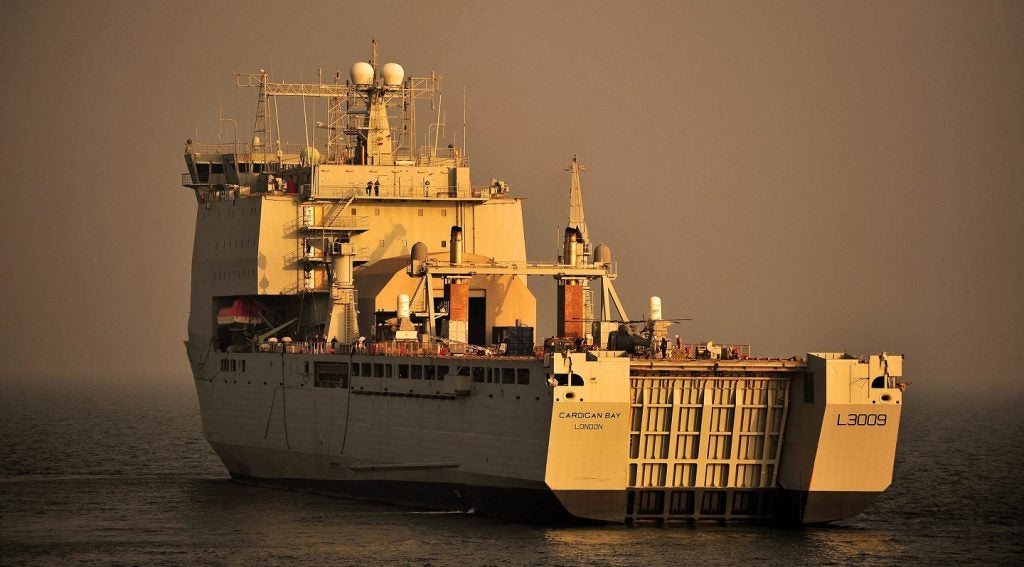
The UK Royal Navy has ended its full spectrum naval capability following the scrapping of two amphibious assault ships, HMS Albion and HMS Bulwark, as part of a slew of defence cuts by the new Labour government in a dark day for the UK military.
Citing funding difficulties and financial black holes, Secretary of State for Defence John Healey told the UK House of Commons on 20 November that Royal Navy’s two Albion-class amphibious assault ships, key naval platforms that offer littoral strike roles for the Royal Marines, were to be axed.
In addition, another of the ageing Type 23 frigates, HMS Northumberland, will not undergo a planned rectification process as it was deemed uneconomic, leaving the Royal Navy with just eight frigate surface combatants left in its fleet.
Instead, the joint military-civilian crewed Royal Fleet Auxiliary (RFA) will now command the sole amphibious assault capability available for the UK, through the remaining three Bay-class landing ship docks and aviation training vessels, RFA Argus.
“Our three Bay-class landing ships and RFA Argus will continue to provide the amphibious capability,” said Healey.

In 2024 RFA sailors, as civilians, were able to go on strike over complaints over wages, recently agreeing to extend their industrial action into 2025. Conversely, the Royal Navy, as a military service, can not do so.
Having operated for years in an extended readiness format – where one vessel was in service and the other kept in ready to be worked up – it was disclosed during the parliamentary session that both Albion-class vessels were unlikely to have sailed before their expected out-of-service dates (2033 for HMS Albion, 2034 for HMS Bulwark), unless required in emergency.
However, an amphibious assault capability was therefore possible, should it have been required. The decision by the UK government has been to end the Royal Navy’s ability to perform such operations, with the savings of the Albion class scrapping stated as being £9m ($11.3m) per year.
A theoretical replacement class of Multi-Role Support Ships (MRSS), initiated by the previous Conservative government, is still in the pre-concept phase, and at least a decade away from coming into service. It is not confirmed how many MRSS vessels will be acquired, nor whether they will be operating by the RFA or Royal Navy.
The RFA though was also nominally hit with the scrapping of two Wave-class fleet tankers, which had not been in service for some time.
Can the Bay class do what Albion and Bulwark did?
No. The Bay-class landing ships are part of the RFA and therefore not full warfighting vessels and built to civilian standards where possible.
This reporter has embarked on a Bay-class LSD previously, spending two days onboard as RFA Cardigan Bay undertook operations in the Arabian Gulf in the 2010s. Capable vessels, certainly, but warfighting they are not.
The core crew of the Bay class are civilian mariners, with Royal Navy personnel tasked with operating weapons and other fitted or embarked military equipment.
In addition, the relative amphibious capabilities are markedly different, with the Albion class able to accommodate twice the number of landing ships as the Bay’s, as well as a greater compliment of troops such as the Royal Marines.
Neither class have aircraft hangers, although the flight deck of the Albion class can accommodate twice the number of rotary platforms as the smaller Bay LSDs.

The Bay‘s are minimally armed, and due to their design are less seaworthy than the Albion‘s due to their large flat surfaces acting as sails to catch open ocean winds.
Construction is also different with HMS Albion and HMS Bulwark were built to the internationally recognised Defence Standard (DEFSTAN), unlike the Bay class.
An Albion class can also operate as a command ship for a larger amphibious strike group, a capability that the UK is supposed to be able to provide to Nato, but now cannot.
Is that the end of cuts to the Royal Navy?
Again, no. Notwithstanding the loss of another Type 23 frigate, described as Healey as being too expensive to repair and make available for sea again, there is a very real prospect that programmes like the MRSS could be reduced in size, while the conceptual Type 32 frigate class, planned to replace the outgoing Sandown– and Hunt-class minesweepers, could also fall victim.
There is also the potential, as previously outlined by Naval Technology, that the Queen Elizabeth-class aircraft carriers, HMS Queen Elizabeth and HMS Prince of Wales, could also be in the crosshairs of the UK government.

With HMS Prince of Wales to undertake a long-planned deployment into the Indo-Pacific region in 2025, and the multi-year gap between the UK’s periodic aircraft carrier deployments, HMS Queen Elizabeth could be mothballed, similar to the format of the now axed Albion-class amphibious assault ships.
“These will not be the last difficult decisions we have to take,” Healey told the House of Commons on 20 November, in a portent of further cuts to come, declining to give specific reassurances regarding the Queen Elizabeth-class carriers ahead of the outcome of the Strategic Defence Review (SDR), which reports next year.
One hopes the AI sifting through SDR submissions is favourable to the idea of the Royal Navy maintaining its two aircraft carriers in service.
In the most positive case, the UK has just capability gapped large-scale naval amphibious assault for a decade. At worst , it may never again such a capability, further diminishing the UK’s claim to have a true full-spectrum, blue water force.
In answer to a January article from Naval Technology, posing the question whether the Royal Navy had an amphibious assault future, an answer appears to have been given.



